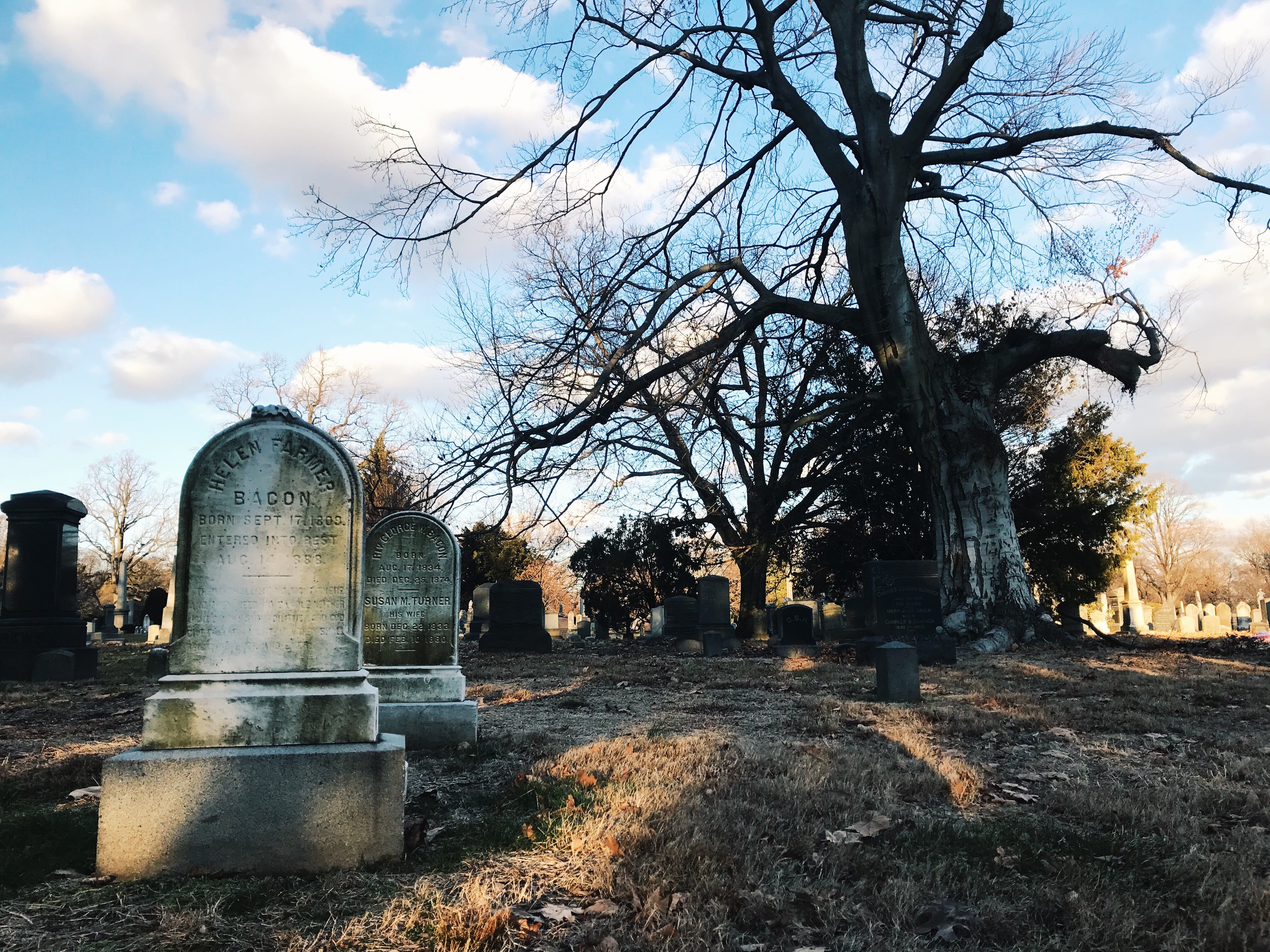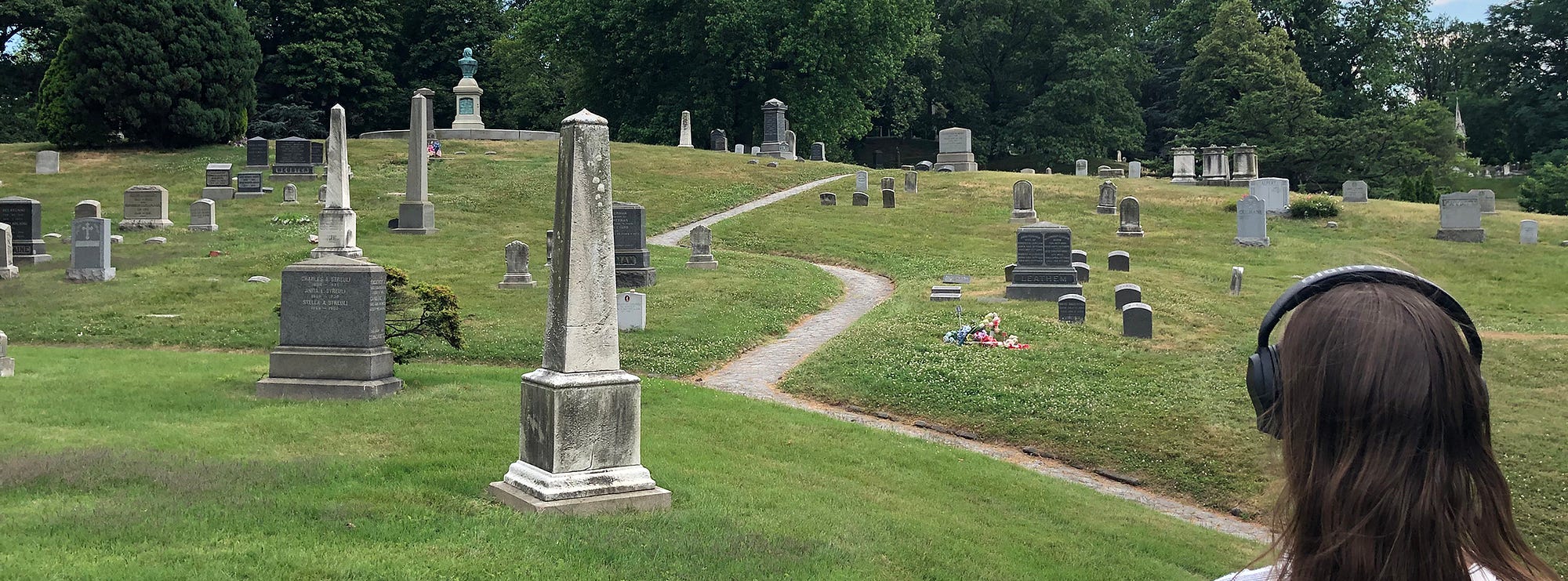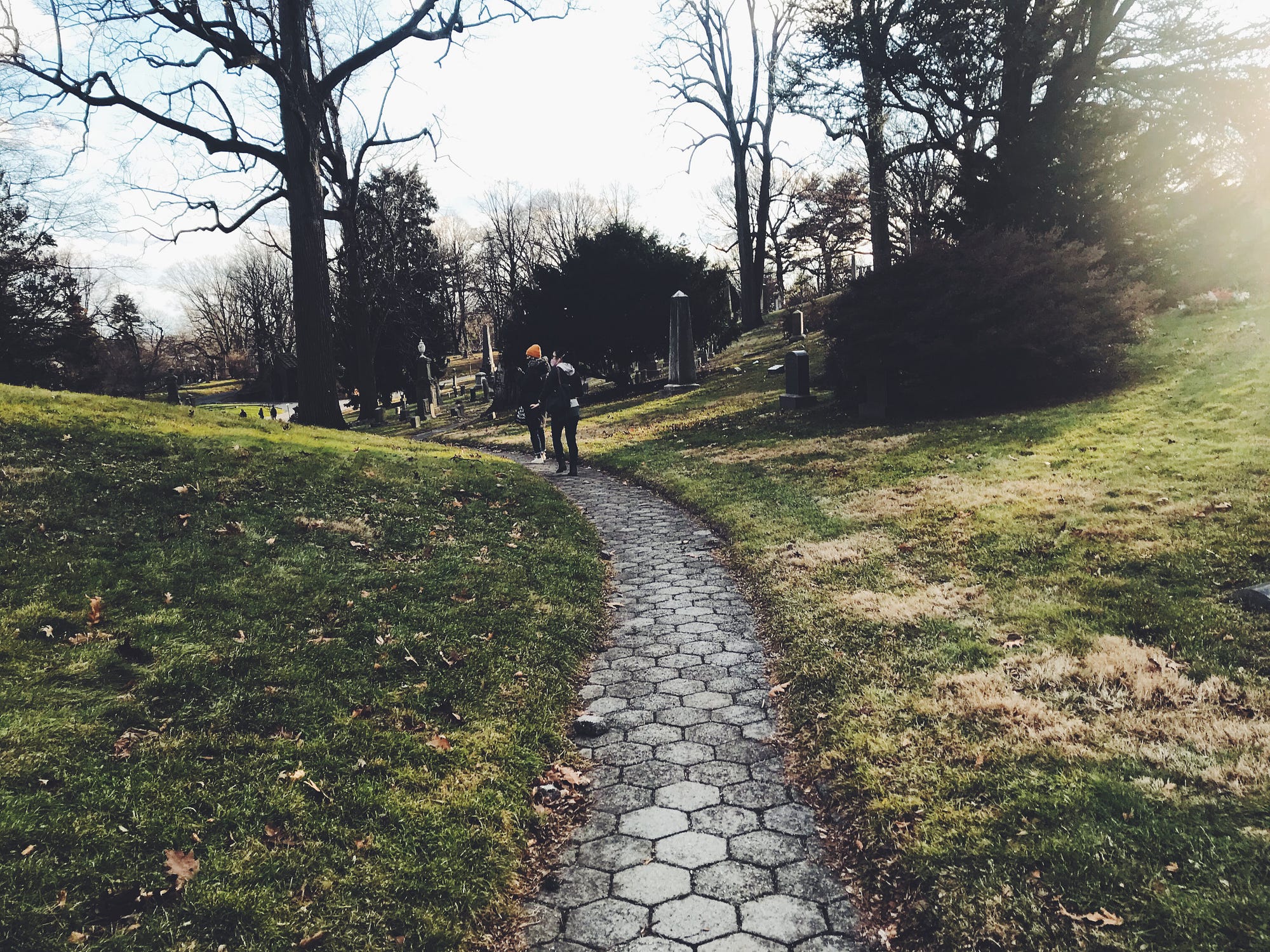
As an audio producer, I make it my secret mission to get people to listen to podcasts with me. When I lived at home with my parents early in the pandemic, I implemented mandatory post-dinner listening sessions. With my friends, I’m a little less imposing, but it’s always an alternative to Netflix. Since I don’t have the same in-person friend access these days, I was excited to find Gelsey Bell’s outdoor podplay Cairns (commissioned by HERE, narrated and written by Bell, with music by Bell and composer Joseph White). Cairns is an immersive audio experience of Green-Wood Cemetery, which is a few blocks southwest of Brooklyn’s Prospect Park.
For those not familiar, a podplay is like a podcast (you are listening, on headphones, to someone speaking), that is often specific to a certain place (such as Green-Wood Cemetery in Brooklyn). The audio of a podplay often guides you around a location as the experience unfolds. You might think of it as a walking tour with sound design. Or in theatre terms, the world around you is the stage. I find the strength of a podplay is that it can build the audience’s connection to a specific location. The audio can enhance aspects of the environment and the location can be used to enhance the story.
Upon discovering Cairns, I looped in three friends willing to spend a day walking through a cemetery. I purchased and downloaded the mp3s from Gelsey Bell’s Bandcamp, told everyone to pack their headphones (while I forgot to pack my own headphones), and headed down. Thankfully the responsible person in the group brought two pairs. When we got to the entrance, we pulled out our respective phones and pressed play together after counting down to make sure we started at the same time.
(Minor spoilers follow.)

The beginning of the piece leads you through a tunnel while listening to a humming/echoing musical intro by Bell, who narrates Cairns. Once we were through the tunnel, she began giving instructions, accompanied by wind sounds and bird calls which created the atmosphere of a Spring day. I was impressed by the instructions at the beginning of the tour like when the narrator pointed out a small red water pump at the exact moment we passed by it. This created the feeling that the environment around us would be the grounds of a scavenger hunt. Through directing our attention to landmarks, we were led down dirt paths, up a steep hill, and past scores of mausoleums and statues. I remember thinking that I would have never walked this route on my own. By gently leading our attention and movement, the experience opened up details of Green-Wood that we would have missed otherwise.
Another opportunity with the medium of podplays is to weave the details from the environment into a story. As we moved through the cemetery, Cairns led us to various graves and told a brief history of the people buried there. We met Do-Hum-Me, an indigenous woman from the Sauk Tribe who died a few weeks after coming to New York and performing in P. T. Barnum’s “infamously racist and extremely popular America Museum.” We learned about Eunice Foote, a scientist in the mid 19th-century who conducted research that informed early discoveries about global warming.
Get Alexa Burke’s stories in your inbox
Join Medium for free to get updates from this writer.
SubscribeSubscribe
I appreciate that the tour mostly pointed out women and people of color, amidst a predominately white, upper-class cemetery. However, while each individual mentioned was significant in their own right, the histories didn’t contribute to a larger narrative. At times the experience felt like a museum audio guide, moving from exhibit to exhibit in an isolated manner, rather than crafting a unified theme. This lack of cohesion was particularly evident at the end of the tour, because, from what I observed, it was the opportunity for what could have been the perfect ending.
The last stop of Cairns was the grave of Dr. Susan S. McKinney-Steward, who, in 1870, was the first Black woman to become a doctor in New York, and the third in the country. Her sister Sarah was the first Black woman to become a principal in the NYC public school system. Sarah’s second husband was a former slave and, in 1865, the first African American to give a speech to Congress. As Bell rightly noted, “We are sitting at the feet of American history royalty.” We were indeed amidst royalty; I just wish that fact had landed more powerfully. Perhaps, as we were walking through the cemetery, we might have been asked to note how few other African Americans are buried here. Maybe if the listener understood that there is a “type” of person who is buried in Green-Wood, but this tour was going to reveal the hidden gems, the people who elbowed their way in here. Or if Bell pointed out specific graves to build context around African American experiences and historical context of the mid- to late-19th century, arriving at the grave-presence of Susan S. McKinney-Steward would have been more striking.
Bell’s role as a narrator in Cairns isn’t quite clear, either. At times, the narrator felt like a friend who was pointing out things she liked about the cemetery from years of visiting. At other times, the narrator seemed to be a yoga instructor, leading our breath and attention to meditate on certain aspects of the environment. And Bell also felt like a historian, guiding us through the injustices that were marked by each grave. This combination of a friend/guru/historian narrator could have worked, but because the story was fragmented and the narrator’s role was also fragmented, it ended up being distracting. What I was longing for were opportunities to sink deeper into a story or experience, be it the narrator’s story or a thread that she was drawing in Green-Wood, and I don’t think this was completely successful.

Though I think the tour could have better pressed into the strengths of the medium, I am glad for the existence of these podplays. Especially in this time when we can’t even watch a movie in each others’ homes, an outdoor media experience that can be done with others hinted at the normalcy of pre-pandemic life. And even better than sitting in the living room together, Cairns led us to hidden gems in a beautiful location. At one point Bell gave instructions to walk up a hill, through dirt paths and over mounds of graves. We reached a pinnacle, and we were told to turn around and look toward the water. There was a stunning view of the Statue of Liberty, lit by the late afternoon sunlight, and I was delighted to stand next to friends amidst trees and graves and history.
Cairns is available now for $7.
Discover the latest immersive events, festivals, workshops, and more at our new site EVERYTHING IMMERSIVE, new home of NoPro’s show listings.
NoPro is a labor of love made possible by our generous Patreon backers. Join them today!
In addition to the No Proscenium web site, our podcast, and our newsletters, you can find NoPro on Twitter, Facebook, YouTube, Instagram, in the Facebook community Everything Immersive, and on our Slack forum.
Office facilities provided by Thymele Arts, in Los Angeles, CA.


















Discussion